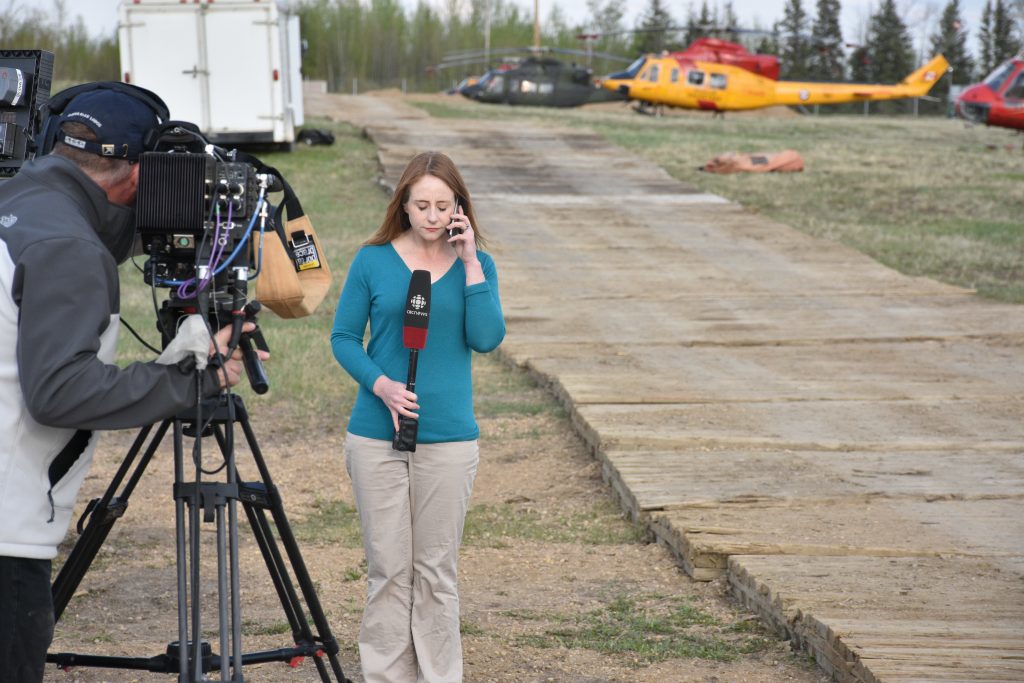When do journalists intrude on communities’ privacy when covering natural disasters?
Crossing the Line
Under a gigantic pile of rubble that used to be a home, a woman laid crushed by the weight of the debris. The deceased’s mother and sister wept, as David Common reported on the scene of the disaster for the CBC. He followed Marie-Nicole Antoine, a young Haitian Canadian, up a makeshift pathway to the back of her family’s destroyed home. Antoine’s sister’s body was trapped under the debris, and her face sunk with grief as she saw her sister, dead. Common, who was standing some distance away, heard Antoine cry and scream. He chose not to follow the sister further. “We didn’t go all the way, and we didn’t need to frankly,” Common says, looking back on that day. “We didn’t need to exploit or intervene in what was a private moment.”
Common reported on the immediate aftermath of the 2010 Haiti earthquake that killed over 220,000 people. While there, he met Antoine, who flew to Haiti to see if her mother and sisters had survived. Her mother was alright, but her sister was the woman who died under the remains of their home. “When someone is finding a loved one who’s dead, how do you report on this respectfully?” Common asks. “It comes with the recognition that when you are there for a moment like that, you are absolutely telling the story about what has happened.”
Disaster stories are important and often devastating to report on. While the Haiti earthquake is one example, there are many disasters where there are significant and horrible losses. Families lose their homes, loved ones, and access to food and water. On top of all these stresses and chaos, people become vulnerable. While it’s important for journalists to tell these tragic stories, it’s also necessary to recognize potential sources’ emotional and psychological burdens. In the pursuit of stories, reporters sometimes get caught up in deadline pressure, leading them to violate journalistic ethics.
In August 2017, CNN reporter Rosa Flores was covering Hurricane Harvey in Texas and spoke to a woman who survived the storm. The woman was shaken up and angry when Flores shoved a microphone in her face. She called Flores out for approaching her during a time of grief live on camera, and the newscast went viral, which sparked a conversation about the media’s exploitation of disaster victims. Could journalists report more empathetically while covering natural disasters?
If a person can barely speak, is sobbing uncontrollably, or is in a state of shock, it’s probably not the best time to approach that individual, says Joe Hight, journalism ethics chair at the University of Central Oklahoma and co-author of Tragedies & Journalists, a guide that helps journalists report on violence. “People go through different levels of grief at different times. You may never know when that person has it.”
[waveplayer ids=”1505″]
Joe Hight discusses how journalists can cause harm by intruding on disaster victims’ privacy. (Daina Goldfinger/RRJ)
When a person reacts harshly, it’s a sign for reporters to back off and understand they are being intrusive. Journalists often practice different codes of conduct in different places. After the 2010 Haiti earthquake, disturbing images were published and broadcast in western media—some of which involved children. In Haiti, it has become common practice for foreigners visiting the country to take individuals’ photos without permission, says Yveline Alexis, an assistant professor of Africana studies at Oberlin College and Conservatory in the United States. “Thinking about [Hurricane] Harvey in Texas, there’s no way I’m taking a camera and taking pictures of white children—or anybody’s children for that matter—without asking permission,” she says.
That permission is key to proper journalistic practice. Journalists need to ensure their sources are providing informed consent, says Kirk LaPointe, a media ethics professor at the University of British Columbia and a former CBC ombudsman. This can be done by showing empathy, asking potential sources if they are okay to talk, and explaining what the story and purpose of the interview are. “You are trying to get them to understand the context of what you’re doing, and if they understand it or not, whether you continue with the interview,” Hight says, adding that a lot of journalists struggle with giving sources permission to say no.
Kirk LaPointe talks on the importance of informed consent when reporting on natural disasters. (Daina Goldfinger/RRJ)

CBC’s Briar Stewart reported on the 2016 wildfire in Fort McMurray, Alberta. At one point, the grass across the street from where she was reporting caught fire. (Courtesy Terry Reith/CBC)
When is it appropriate to approach sources in the midst of a natural disaster? This is a question CBC News reporter Briar Stewart grappled with when she covered the Fort McMurray wildfire. During the aftermath of the 2016 disaster, Stewart saw many people return to homes that were burned down. Some people cried and sobbed, and it was clear that they did not want to speak to the media. Stewart needed to mediate between displaying the magnitude of the event and respecting people’s space. “If someone really didn’t want to be on camera, we would not put them on camera,” she says.
An aspect of disaster coverage involves ‘parachute’ reporting, meaning that journalists are sent to cover a devastation in a community that they do not belong to. Parachute reporting may pose problems of exploitation if journalists are not knowledgeable about the community they are covering. Linda Kay, a journalism professor at Concordia University, has researched reporting on traumatized populations. In one of her studies, she found that journalists hindered people’s recoveries by being uninformed and intrusive. Be sensitive to what a community is about and who they are, Kay says.
Common also stresses the importance of being sensitive and humane when reporting. “We’re humans. I never want to be right in someone’s face,” he says “I want to be respectful as possible. I want to know that if they are clearly not comfortable with us being there, then probably we shouldn’t be.”

